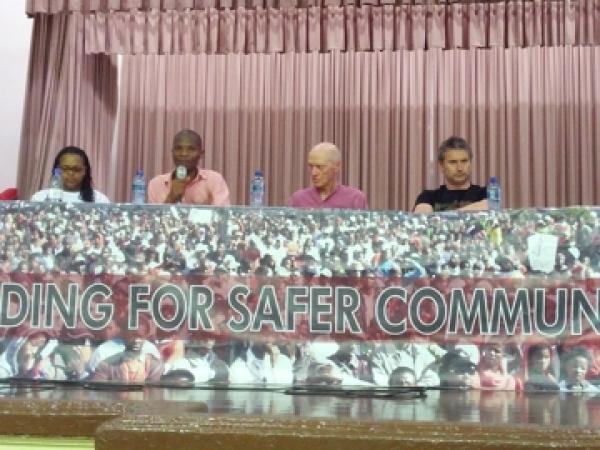Can urban upgrading create safer communities?

The third lecture of this year’s Grootboom Memorial Dialogue Series took place at the Woodstock Town hall last night. Hosted by the Social Justice Coalition (SJC), the dialogue explored the impact of urban design interventions on the safety and security of people living in informal settlements.
“We have an advantage. We can change our community because we know it well,” said Nthuthuko Vika, a 24 year-old SJC activist.
A lack of adequate housing and basic services in South Africa influences how communities perceive their safety. Speaking at the dialogue, a researcher at the University of Cape Town African Centre for Cities (ACC), Mercy Brown-Luthango, said that a recent study indicates that urban upgrading has various effects on perceptions of safety in communities.
The study was conducted with focus groups, the police and residents in the Mitchell’s Plain settlement, Freedom Park, home to more than half a million people and 100,000 dwellings.
Preliminary findings indicate that perceptions of safety had not changed significantly. Residents in Freedom Park still feel unsafe and insecure despite the urban upgrades.
Located between two rival gang turfs, Freedom Park was founded in 1998 after a group of disheartened citizens occupied the land and built shacks for themselves.
“People stayed there for 3 years without any services. Government only initiated urban upgrades 10 years after the occupation. The prevalence of gang-related crime and violence still persists,” said Brown-Luthango.
An increase in shebeens and drug dens has contributed significantly to the prevalence of violent crime. The ACC study claims that before urban upgrades, 52 common crime spots were identified in Freedom Park. Years later, after the upgrading, the community now has 81 common crime spots. Most of the crimes reported occur within a 50 metre radius of shebeens.
According to the study, urban upgrading alone is not sufficient to deal with the challenge of urban violence. Brown-Luthango added that existing policies relating to safety and housing fail to draw the link between spatial inequality, exclusion and violence.
“This does not mean that urban upgrades have failed. Instead, it means that urban upgrading should go beyond physical design. It is important to build inclusive social networks and improve the socio-economic conditions in communities” he said.
Matthew Krause from the Khayelitsha based project, Violence Prevention through Urban Upgrading (VPUU), shared some of the successes this project has had in contributing to crime prevention and promoting community wellness.
“Our approach is to work with communities to identify the public spaces they would like to see become more safer. We then activate these public spaces through a precinct plan that provides communities with a live-work-play environment,” he said.
Community members close to the VPUU project voiced their mixed reactions at the dialogue. A young activist from the SJC asked Krause about the delay of the BM and TR section (suburbs) upgrades in Khayelitsha, saying the boards about the upgrades had been up since 2010, but not much had happened.
Krause responded that delays with the BM and TR section upgrades were because the City of Cape Town had decided to undertake the project with different partners and not the VPUU.
Sizwe Mxobo from the Informal Settlements Network , who also attended the dialogue, said, “In Mshini Wam [located in greater Joe Slovo Park in Milnerton], we asked the community members how best they could prevent shack fires.”
The design intervention applied was simple yet effective. Through re-blocking, 250 shacks were spatially reconfigured. Residents now have access to basic amenities and the risk of shack fires has been mitigated through re-blocking. The incremental upgrade by the community also includes passages designed to allow the passing of large emergency vehicles.
“The community members in Mshini Wam did the mapping and enumerations themselves. Through savings, community members also installed drains,” said Mxobo.
John Cartwright, an independent safety consultant and co-author of the book Where is my chicken? Making South Africa Safer, suggested that the focus should move on empowering communities to deal with disputes and crime.
“The Peace Committees in the 1ate 1990s offered community members an equitable place to determine a community specific compact that everyone bought into,” said Cartwright.
Ultimately, the ability of communities to deal with the challenge of urban violence will require strong support from government agencies. Communities need to organize themselves through policing forums and other networks to effectively promote crime prevention. This can give community members a sense of control, even though the levels of violence remain a problem.
Support independent journalism
Donate using Payfast

Don't miss out on the latest news
We respect your privacy, and promise we won't spam you.

This article is licensed under a Creative Commons Attribution-NoDerivatives 4.0 International License.
